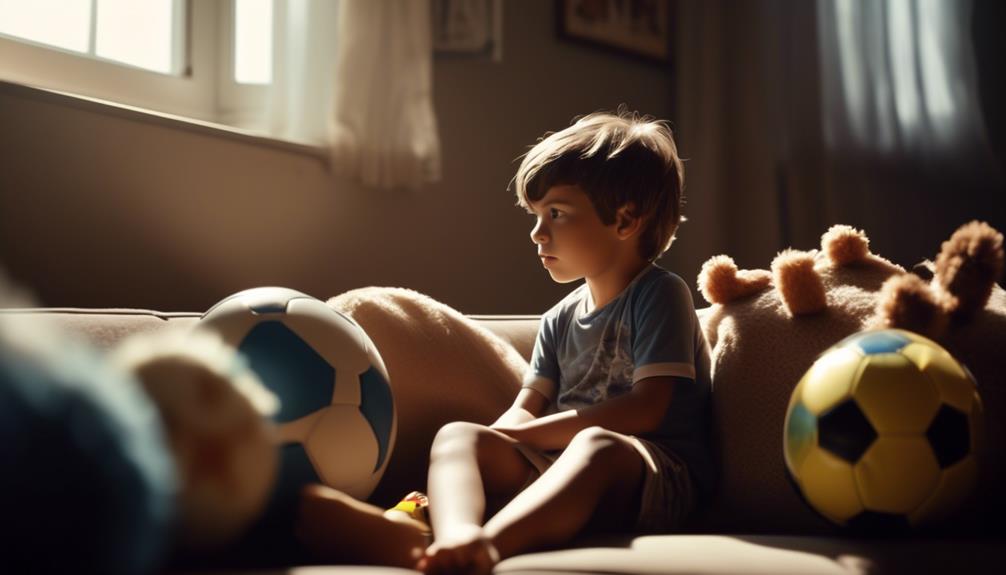When to Worry About Your Child's Inactivity Levels

You should start worrying about your child's inactivity levels when they show signs of excessive screen time and experience health risks associated with a lack of physical activity.
Taking action to promote an active lifestyle and encourage active play is crucial for their overall well-being.
Signs of Decreased Physical Activity
If your child shows an unwillingness to engage in active play or outdoor activities, it may be a sign of decreased physical activity. According to the physical activity guidelines for children, it's recommended that children aged 6-17 engage in at least 60 minutes of moderate to vigorous physical activity every day.
However, many children today aren't meeting these guidelines due to increased sedentary behaviors. Spending excessive time in sedentary activities such as watching TV or playing video games can contribute to a decrease in physical activity. If your child is spending more time sitting and less time being physically active, it's important to address this issue.
Decreased interest in sports or physical activities that were previously enjoyed is another sign of decreased physical activity. Additionally, fatigue or lack of energy even during routine daily activities and a lack of muscle strength and endurance during physical activities can indicate a decrease in physical activity levels.
It's crucial to limit screen time and encourage your child to be physically active to promote their overall health and well-being.
Impact of Excessive Screen Time
Excessive screen time not only contributes to decreased physical activity levels in children but also hinders the development of motor skills and physical literacy. Research has shown that excessive screen time is a primary risk factor for physical inactivity in preschoolers, which can lead to a range of health problems. The American Academy of Pediatrics recommends limiting screen time to video-chatting for children under 18 months and no more than 1 hour a day for ages 2 to 5. By exceeding these guidelines, children and adolescents are at a higher risk of developing physical inactivity, which can have long-term consequences for their health.
Excessive screen time can impede the development of motor skills, as children need active play and movement to develop coordination, balance, and strength. It also hinders the development of physical literacy, which is the knowledge, skills, and confidence to participate in physical activities. Without sufficient physical activity, children are more likely to experience health problems such as obesity, cardiovascular diseases, and musculoskeletal issues.
To mitigate the negative impact of excessive screen time, caregivers should limit screen time in preschoolers, providing more opportunities for physical activity. Encouraging a variety of sports and physical activities can help promote physical activity in youth and counteract the effects of excessive screen time. By prioritizing physical activity and reducing screen time, we can support the overall health and well-being of children and adolescents.
Health Risks Associated With Inactivity
Inactivity can have serious health risks for children. A sedentary lifestyle puts them at risk for conditions like obesity, high blood pressure, high cholesterol, asthma, joint problems, and type 2 diabetes.
In addition to physical health consequences, inactivity can also have negative implications for their mental well-being.
Sedentary Lifestyle Risks
Sedentary behavior in children significantly increases the risk of obesity, high blood pressure, high cholesterol, asthma, joint problems, and type 2 diabetes. Prolonged sitting and excessive screen time can contribute to childhood obesity, leading to long-term health issues.
Inactivity hinders the development of motor skills and physical literacy, which affects overall physical and cognitive development in children. Furthermore, sedentary behavior during childhood and adolescence is linked to an increased risk of chronic diseases later in life.
This emphasizes the importance of promoting physical activity from a young age to reduce the risk of various health problems and ensure overall well-being. Addressing sedentary behavior and promoting physical fitness is crucial in preventing the onset of these chronic diseases.
Physical Health Consequences
Physical inactivity during childhood can have significant negative impacts on a child's overall health and well-being. Lack of physical activity can lead to a range of health risks, including obesity, high blood pressure, high cholesterol, asthma, joint problems, and type 2 diabetes. The American Heart Association and the Centers for Disease Control emphasize the importance of regular physical activity in children for better cardiovascular health, stronger bones and muscles, and improved mental well-being. Encouraging kids to be physically active can also have positive effects on school attendance, academic performance, and reduced symptoms of anxiety and depression. Inactivity can impede the development of motor skills and physical literacy in children, making it crucial to prioritize regular physical activity for their overall health and development.
| Health Risks Associated With Inactivity |
|---|
| – Obesity |
| – High blood pressure |
| – High cholesterol |
| – Asthma |
| – Joint problems |
| – Type 2 diabetes |
Mental Health Implications
The negative impacts of physical inactivity on a child's overall health and well-being extend beyond physical consequences, with significant mental health implications as well. Here are three important mental health implications of inactivity levels in children:
- Increased risk of mental health disorders: Studies have shown that sedentary behavior in children is associated with an increased risk of mental health disorders such as depression and anxiety. Lack of physical activity can contribute to feelings of low self-esteem, social isolation, and poor body image.
- Impaired cognitive function: Regular physical activity has been found to enhance cognitive function in children, including improved attention, memory, and problem-solving skills. Conversely, inactivity can lead to decreased cognitive performance and academic difficulties.
- Elevated stress levels: Physical activities help to reduce stress and promote relaxation. Inactive children may experience higher stress levels, which can negatively impact their mental well-being and overall quality of life.
It is crucial to prioritize physical activities and encourage active play in children to promote better mental health outcomes and overall well-being.
Importance of Physical Education
Physical education is crucial for children as it offers numerous health benefits. Engaging in physical activity not only improves motor skills and physical literacy but also enhances cognitive function.
Furthermore, research suggests that physical education has a positive impact on academic performance and can contribute to long-term well-being.
Health Benefits of PE
Engaging in physical education not only enhances children's development but also improves their motor skills and physical literacy. Here are three important health benefits of PE for children:
- Physical activity: PE provides children with an opportunity to engage in regular physical activity, which is crucial for their overall health and well-being. Regular physical activity helps to maintain a healthy weight, strengthen bones and muscles, and reduce the risk of chronic diseases.
- Cognitive function: Research shows that participating in PE programs can contribute to improved cognitive function in children. Physical activity has been linked to enhanced attention span, memory, and problem-solving skills, which can positively impact academic performance.
- Inactivity levels: PE programs can help combat sedentary behavior and reduce inactivity levels in children. By providing structured physical activity during school hours, PE encourages children to be more active and less sedentary, which is important for their long-term health and development.
Impact on Academic Performance
Improving academic performance goes beyond cognitive skills; physical education plays a vital role in enhancing students' overall learning potential.
Engaging in physical activity during the day can have a positive impact on academic performance. Research shows that physical activity improves cognition, attention, and memory, leading to better academic outcomes. Students who participate in regular physical education classes have been found to have higher test scores and grades compared to those who do not.
Additionally, physical education provides an opportunity to develop important life skills such as teamwork, discipline, and goal-setting, which can further contribute to academic success.
School administrators should prioritize and expand the frequency and quality of physical education to ensure students have sufficient time for physical activity throughout the day. By integrating physical education into the curriculum, we can help students excel academically while promoting their overall well-being.
Long-Term Effects on Well-Being
To ensure long-term well-being, incorporating physical education into your child's life is crucial for developing essential motor skills and physical literacy. Here are three reasons why physical education is important for your child's well-being:
- Improved Physical Health: Regular participation in physical education helps children stay active throughout the day. Engaging in moderate to vigorous physical activity not only strengthens their muscles and bones but also reduces the risk of chronic diseases such as obesity, diabetes, and heart disease.
- Enhanced Mental Well-being: Physical activity has been shown to have a positive impact on mental health. Participating in physical education can help reduce stress, anxiety, and symptoms of depression, while also improving mood and overall well-being.
- Social Development: Physical education provides opportunities for children to interact and collaborate with their peers. It promotes teamwork, communication, and cooperation, helping them develop important social skills that are essential for building relationships and succeeding in various aspects of life.
Pros and Cons of Youth Sports
Participating in youth sports can significantly increase physical activity levels in children and adolescents. It provides opportunities for physical activity through organized practices, games, and competitions. High school students who participate in sports are more likely to engage in moderate-to-vigorous intensity physical activity compared to those who don't participate. This is important because moderate-to-vigorous intensity physical activity is necessary to reap the health benefits associated with physical activity, such as improved cardiovascular fitness, bone health, and mental well-being.
However, it's essential to acknowledge that not all youth sports provide equal opportunities for physical activity. Some sports may focus more on skill development or game strategies, leaving little time for vigorous physical activity. It's crucial to encourage a variety of sports and physical activities to ensure that youth have ample opportunities for physical activity. This can help promote a well-rounded approach to fitness and prevent burnout from repetitive movements or overtraining.
Despite the potential drawbacks, organized sports are expected to directly increase physical activity levels among youth. The gateway effect theory suggests that participating in organized sports can lead to higher levels of physical activity during free play. This means that involvement in sports can have a positive trickle-down effect, motivating children and adolescents to engage in physical activity outside of structured sports settings.
Strategies to Encourage Active Play
Encouraging active play in children is crucial for promoting physical activity and overall well-being. Here are three strategies to help you encourage active play in your child:
- Prioritize outdoor play: Provide opportunities for physical activity and exposure to natural environments. Outdoor play allows children to engage in a variety of physical activities such as running, climbing, and biking. It also helps them develop their motor skills and connect with nature.
- Incorporate a variety of physical activities: Offer a range of activities that appeal to your child's interests and abilities. This can include water play, ball games, dancing, and obstacle courses. By providing different options, you can keep them engaged and excited about being physically active.
- Limit screen time and encourage active play throughout the day: Children spend a significant amount of time in sedentary activities like watching TV or playing video games. To ensure they get the recommended 60 minutes of physical activity, limit their screen time and encourage them to be active throughout the day. Break up sedentary periods with short bursts of physical activity, such as jumping jacks or a quick game of tag.
Role of Families in Promoting Physical Activity
Families play a crucial role in promoting physical activity for children by encouraging active play and outdoor activities in their daily routines. By providing opportunities for kids to engage in physical activity, families can help them develop healthy habits that will benefit them throughout their lives. Here are some strategies that families can use to promote physical activity:
| Strategies to Promote Physical Activity |
|---|
| Encourage active play and outdoor activities |
| Limit screen time and promote active alternatives |
| Be a role model for physical activity |
| Make physical activity a family priority |
| Provide safe and accessible spaces for play |
Encouraging active play and outdoor activities can help children develop their motor skills, improve their cardiovascular health, and enhance their overall physical fitness. Limiting screen time and promoting active alternatives, such as going for a walk or playing a sport, can help children reduce sedentary behavior and increase their physical activity levels. Being a role model for physical activity by engaging in regular exercise yourself can inspire and motivate children to be active. Making physical activity a family priority by scheduling regular active outings or setting aside time for physical activities together can help ensure that physical activity becomes a regular part of every day. Finally, providing safe and accessible spaces for play, both within the home and in the community, can make it easier for children to engage in physical activity. By incorporating these strategies into their daily routines, families can play a significant role in promoting physical activity and helping children develop lifelong healthy habits.
Frequently Asked Questions
How Long Is Too Long for Inactivity?
Sitting for too long can have negative effects on your health. It is recommended to avoid a sedentary lifestyle by engaging in daily physical activity. Encourage movement and play to counteract prolonged inactivity.
What Are the Consequences of Inactivity in Children?
You should worry about your child's inactivity levels because it can have serious consequences. It increases health risks, contributes to the obesity epidemic, hinders cognitive development, and has negative social and emotional impacts.
What Happens if a Child Doesn't Get Enough Exercise?
If your child doesn't get enough exercise, they may be at risk for obesity, poor sleep, decreased cognitive function, and mental health issues. Regular physical activity is crucial for their overall well-being.
What Are the Symptoms of Lack of Exercise in Kids?
If your child lacks exercise, signs may include low energy, fatigue, weak muscles, poor coordination, behavioral issues, and disrupted sleep. These effects can increase the risk of weight gain, obesity, and chronic diseases.











